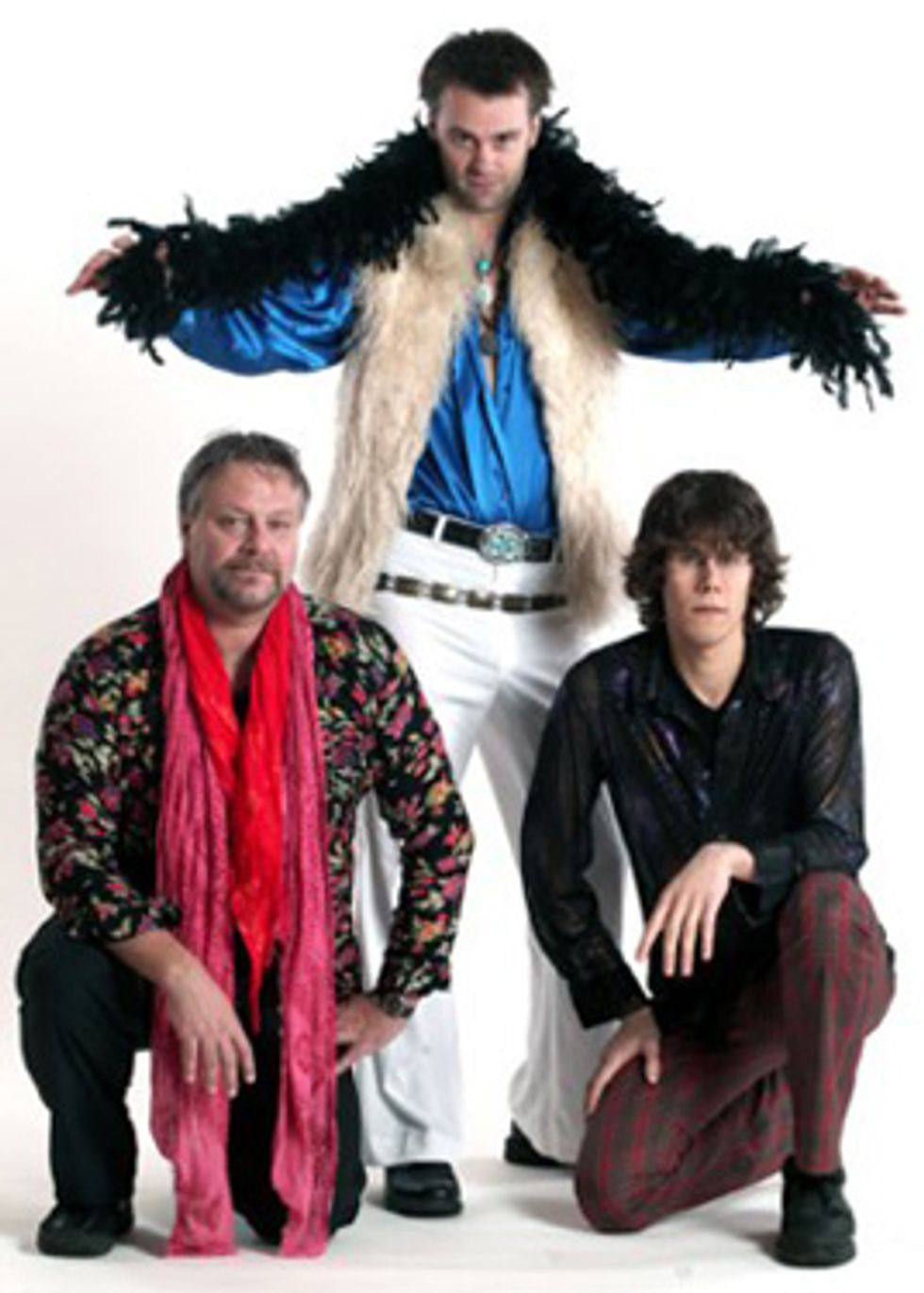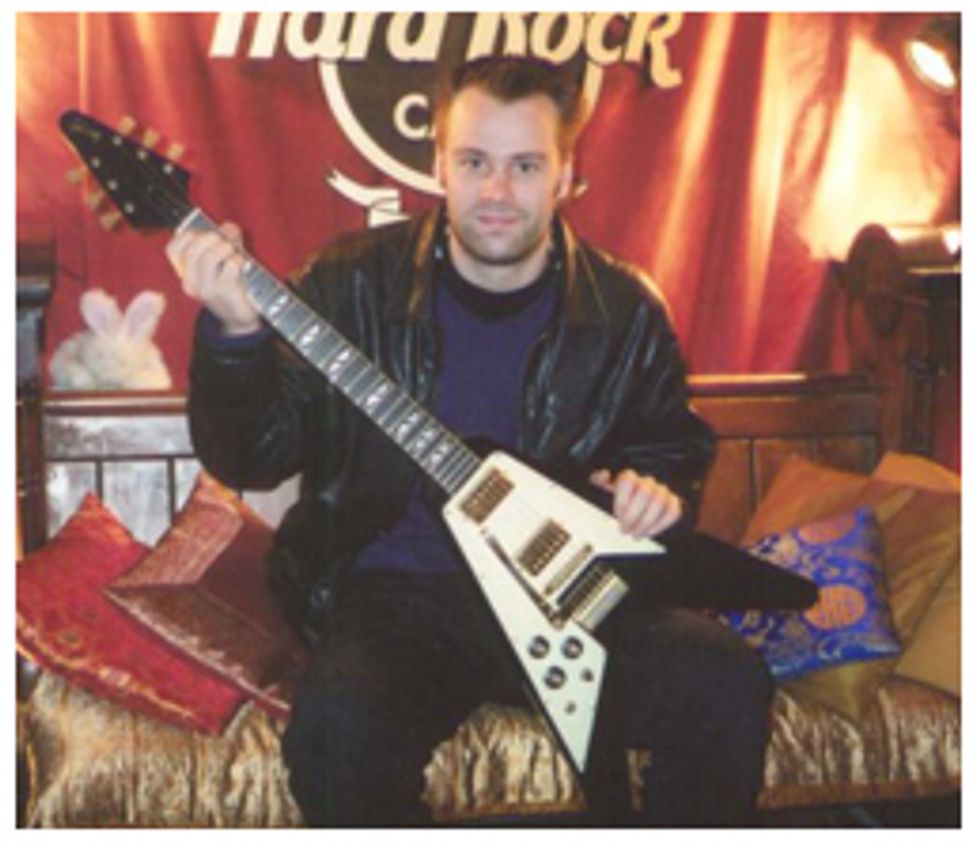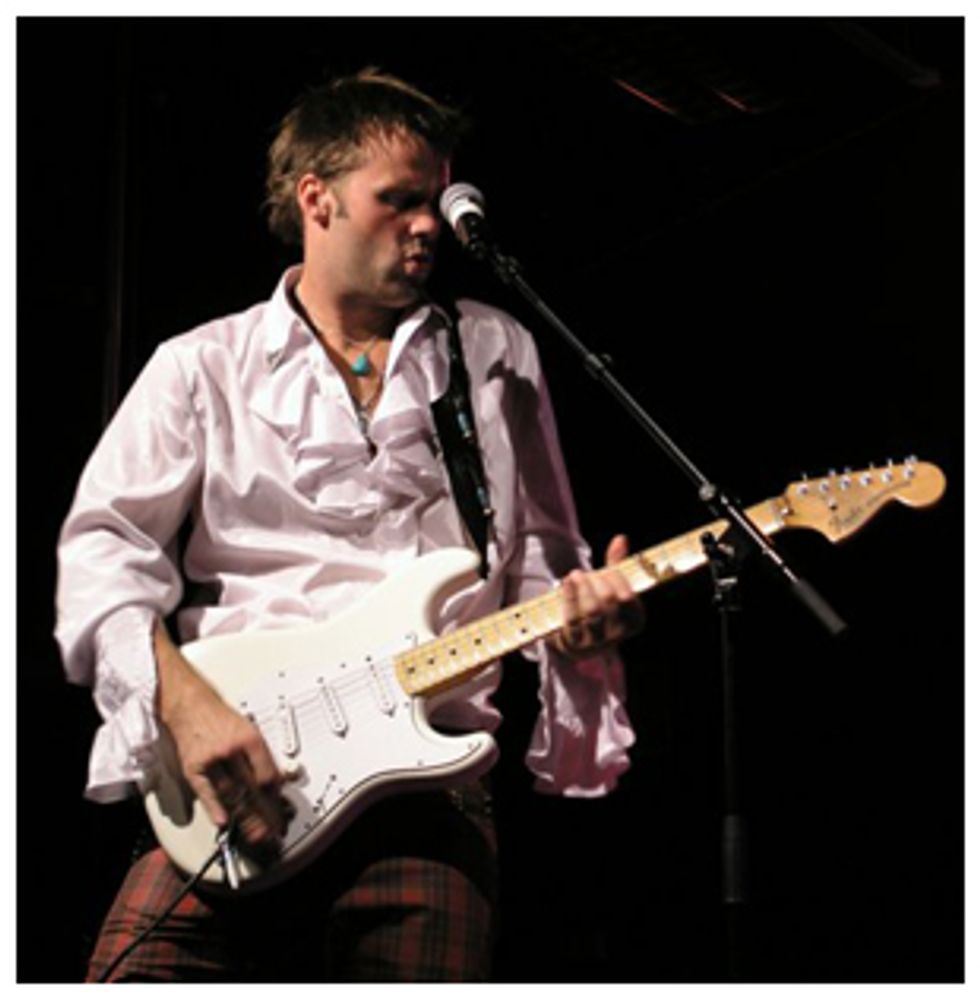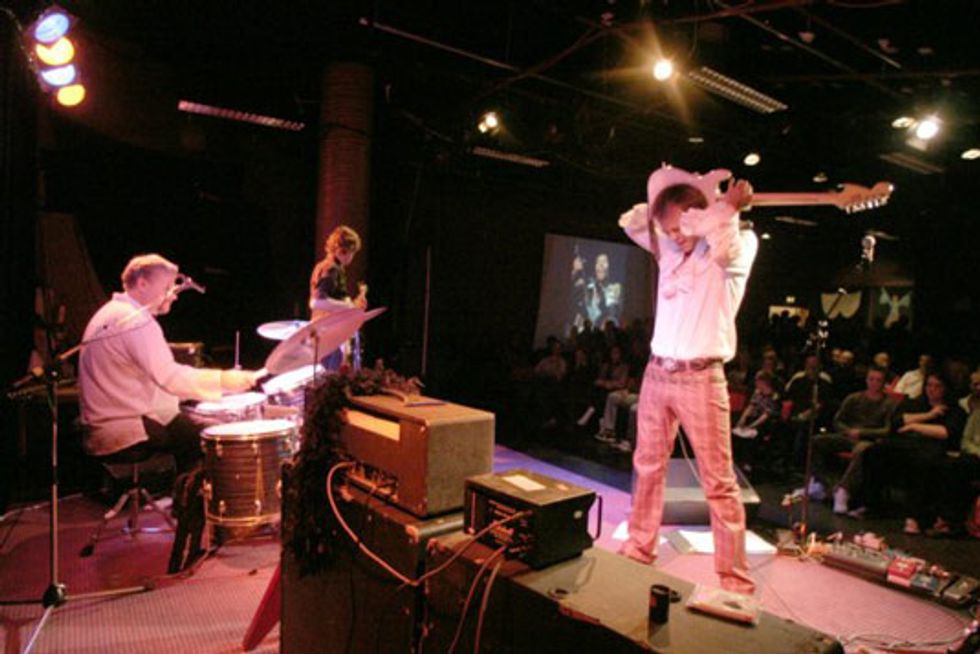Forty years after the brief, meteoric transit of Jimi Hendrix as a concert and recording artist, his impact still resembles the explosive crash of some unexpected visitation from outer space – or perhaps, more appropriately, an avatar of a higher power, who didn’t merely play the guitar but plucked the raw sinews of the heart and soul, and bent the superstings of time and space.
Devotees do tend to speak of him in religious terms. As Gary Kamiya wrote for Salon.com: “There''s only one church in rock: the First Congregational Church of the Guitar. And Jimi Hendrix owns that turf. There are a lot of ways you can become a rock legend, but the best way is the simplest: play the guitar better than anyone else. And Jimi didn''t just shut everybody else down, he burned them alive, toasted them, left a whole Gibson nation gaping with this dumbfounded look on their faces and the axes falling from their lifeless fingers. He Michael Jordaned their hapless asses, and they thanked him for the honor.”
A Church of Jimi Hendrix actually used to exist in San Francisco, and there’s still a Hendrix Internet newsgroup called the “Electric Sky Church,” after Jimi’s own description of his music. When English guitarist Robin Trower emerged from Procol Harum in the 70s with a new Hendrix-drenched sound, he quickly learned that to the particularly worshipful any evocation of the Hendrix sound was considered not merely presumptuous, but a sacrilege. His perplexed response was something along the lines of, “Whom should I be influenced by, if not the best?”
The congregation of Hendrix devotees is still world-wide and growing, and nowhere is the veneration more open and persistent than in Europe, where Swedish acolytes recently celebrated the 40th anniversary of the “Electric Ladyland” recording with a tribute concert tour performed on vintage equipment and recorded for Swedish radio.
The principal organizer of the event was guitarist Stefan Edfeldt, whose band, Ducks Can Groove, (the name comes from a line in “Rainy Day, Dream Away”) plays Hendrix songs exclusively, both in concert and on their CD “Electric Voodoo Vibe.”

Edfeldt and several of his fellow Hendrix fanatics are also in the midst of a “Jimi in Sweden” project that will produce a coffee table book documenting Hendrix’s time in Sweden, where he played more than 30 shows.
Edfelt was born in May 1970, “the same night Jimi played a concert at Will Rogers Coliseum in Fort Worth Texas,” to be exact. But he wasn’t exposed to Hendrix music until 14 years later: “My sister’s boyfriend at that time played the ‘Live at Monterey’ vinyl ALL THE TIME in my sister’s room!! And I just couldn''t get it: To me it was nothing but a noisy racket.
“But since he kept on playing that same album over and over again, it began — totally unexpectedly — to be interesting after some time. There was something there that I actually could relate to. I think I needed that explosive relief that I got from listening to him. So I got stuck and bought more albums, and of course picked up a guitar for the first time ever. At 15 I got my first guitar, and it''s been downhill ever since.”
Soon Stefan’s interest expanded from listening to and imitating Jimi’s “mysterious tones” to a quest worthy of an academic historian: “I started putting ads in various papers, mostly in free classified sections, asking for people with pictures, tapes, films and gear connected to Jimi. I figured that guys and gals with Jimi-stuff would have gotten other interests in life, like sailing, golf, etc., so I targeted any type of magazines that had free ad sections.”
After a few years, this activity drew the attention of others with the same interests: “I was contacted by the other two Swedish nuts in this ‘Jimi In Sweden’ book project. We hooked up and found out we had the same outlook on Jimi and on life in general. This must be something like 12 years ago. Since then we''ve made so many trips all across Scandinavia, interviewing people and meeting many photographers, and we''ve had a lot of fun. Logically, the book should have been finished by now, but new stuff still keeps cropping up.”
The performance side of Stefan’s Hendrix fixation has been similarly dedicated and systematic. “I''ve spent many, many hours listening to live recordings (mostly bootlegs) analyzing different sounds and versions of each songs,” he says. “It''s so fascinating how he changed the song’s arrangements and pace from night to night on tour. Some nights he was in a great mood and could play fluidly, with amazing timing, and some other night you can hear him struggling with lack of inspiration and equipment hang-ups.”

With Ducks Can Groove, Stefan strives for authenticity, playing on vintage Stratocasters, as well as the same vintage model Flying V that Hendrix played in some of his Sweden gigs. And even though there are now modestly priced modules with presets that digitally recreate Jimi’s most famous timbres, Stefan is sticking to period equipment. “I started out with a 50-watt Marshall from the ‘60s, but I didn''t want to carry so many amps (like Jimi did) so I had to switch to a 100-watt model to reach the sound-level that would open up the sound and feedback without getting too-mushy distortion,” he explains. “I agree with what Jimi said, about something happening with the air and vibrations once you go beyond a certain sound pressure.
“At that time the old plexi tops were beyond my means, but as the early ‘70s metal front models were identical inside, so I settled for a good sounding 1971 Marshall bass 100-watt top. I was also lucky enough to find two slanted cabinets with 30-watt Celestion Greenbacks. These two cabinets can take all the power from the Marshall without any problem whatsoever. Usually, I also use a THD Hotplate power brake to slightly reduce the volume, while still retaining the right type of power tube distortion.

“It''s of course a lot of fun to try and mimic Jimi''s setup when it comes to his gear, but a bit expensive if you go all the way with everything original vintage. I''ve tried to keep some balance in the madness, and I''m sure there are many new amps that can match this old ‘71 Marshall''s sound and distortions, but so far I haven''t come across any. So I''m very happy with this amp/speaker setup.
“Early on I found it interesting looking at pictures of Jimi playing live, trying to see what pedals he was using. So I found a nice Fuzz Face, wah and the Vibra-Chorus and realized that they sounded just awesome. One way I was able to save some money in this vintage quest was the fact that the Univibe pedals actually were sold with a different name over here in Scandinavia. They look exactly the same inside and out (except they lacked the speed-pedal), and they were called the Vibra-Chorus, and were made at the same factory by the same company as the Univibes. Turns out that many electronic accordion-players in Scandinavia used to use them to get a Leslie sound, so for a while you could pick up these Univibe originals for a low price. Same with the Fuzz Faces: I started early enough to look for them, so the prices hadn''t yet reached the rooftops.”
“I used the Fulltone ‘69 fuzz for a long time (and used it on “Electric Voodoo
Vibe”) and was very happy with it, until I found my latest vintage Fuzz Face that I absolutely love. It has such a great character, it’s almost like it has a soul.”
Of course, although 40-year-old equipment is authentic, it also comes with its challenges. “It helps out if you have a friend that can assist you when they aren''t that cooperative anymore,” Stefan puts it. “My Vibra Chorus has broken down maybe four times now. And you simply can''t hand them over to your local repairman at the music store. They have to have the deepest respect for vintage gear and know exactly how they are supposed to sound, otherwise they will ruin them for you.
“Actually I’ve got two friends that are complete experts on vintage guitar equipment, David Morin and Håkan Persson. They have helped me a lot and I can say that without their support I could never get the sound that I have now. Also I am fortunate enough to have a local music store where there is a guy working as a repairman that happens to be an electronic wizard, Rune Ågevall. He has been around since they sold Fuzz Fazes and Vibra Choruses, so I have gotten tremendous help from him too. But of course I''ve spent tons of hours testing pedals and fiddling about with my gear, trying to improve my sound.”

Stefan’s quest for Hendrix authenticity extends to the playing itself, but he is not a Jimi-mimic who recreates recorded performances note for note. Instead, he seeks to inhabit the spirit of improvisational adventure that makes Hendrix so compelling.
“When I started playing the electric guitar in 1985, most of my friends were into the heavy metal music scene like Yngwie Malmsteen and that type of playing-technique,” he says. “But I felt there was not much feeling in those songs. I was into Albert King, Freddie King and Stevie Ray Vaughan and other, similar blues artists. So when I got my first band together around 1987, we did a lot of blues standards and some original material. And this was the first time I could play Hendrix songs with drums and bass, so I realized just how much fun it was doing songs like “All along the Watchtower,” “Hey Joe” and so on.
“During the years that followed I got into more and more advanced songs, like ‘Izabella,’ ‘Freedom,’ ‘Are You Experienced?’ and ‘Machine Gun.’ So I had to find musicians who could keep up with those songs. And from there it just keeps on rolling, and I love it!!
“I know there are people who think it''s even sort of a sacrilege to play too much like Hendrix. Just a few days ago I got a really angry comment on one of my videos on You Tube: ‘some douchebag acting like he''s the greatest guitarist ever…’ I think Hendrix gets very personal for people who love him, so they might easily get angry and write harsh comments. But most of the comments and emails I get (hundreds and hundreds) are questions about the equipment, and appreciations for what I do.
“The reason I play Hendrix with a ‘Hendrix-sound’ is very simple, because it really is the best sound there is for that type of music! Jimi knew what he wanted and got it together perfectly.
“People generally seem to understand and appreciate what I''m doing, telling me sometimes that I have a certain touch and that they feel I''m one of few who really dare improvise so freely. I don''t rearrange the songs that much, but my thing is improvising! Much like Jimi did live. ‘Machine Gun,’ which probably is my favorite Hendrix composition to play, is a real challenge because it''s so naked. Just one chord, some very free floating lyrics intermingled with loads of crying blues and emotional sounds.
Of course, there are many Hendrix-tribute bands playing all the hits, but not that many try handling songs like ‘Machine Gun’ or ‘1983 (a merman I should turn to be).’
Those songs can easily fall apart any time, and that''s something you don''t want happening when performing live.
“I like that nerve when playing Hendrix compositions. If you listen to many of the copycats out there, you can hear how they play note for note, and sure, with ‘Hey Joe’ it works fine but try it with ‘Machine gun’! That would just be pointless. I really feel free when playing Jimi Hendrix. Free and happy.”
Stefan confirms that Ducks can Groove will tour in the US this fall, but the itinerary isn''t set yet. And there is also a European tour in the works.
Links:
Ducks Can Groove website
Ducks Can Groove MySpace
The "electric sky church" newsletter
A website with tons of info on Jimi Hendrix tribute recordings, and links to other tribute bands











![Rig Rundown: Russian Circles’ Mike Sullivan [2025]](https://www.premierguitar.com/media-library/youtube.jpg?id=62303631&width=1245&height=700&quality=70&coordinates=0%2C0%2C0%2C0)












![Rig Rundown: AFI [2025]](https://www.premierguitar.com/media-library/youtube.jpg?id=62064741&width=1245&height=700&quality=70&coordinates=0%2C0%2C0%2C0)




















 Zach loves his Sovtek Mig 60 head, which he plays through a cab he built himself at a pipe-organ shop in Denver. Every glue joint is lined with thin leather for maximum air tightness, and it’s stocked with Celestion G12M Greenback speakers.
Zach loves his Sovtek Mig 60 head, which he plays through a cab he built himself at a pipe-organ shop in Denver. Every glue joint is lined with thin leather for maximum air tightness, and it’s stocked with Celestion G12M Greenback speakers.











